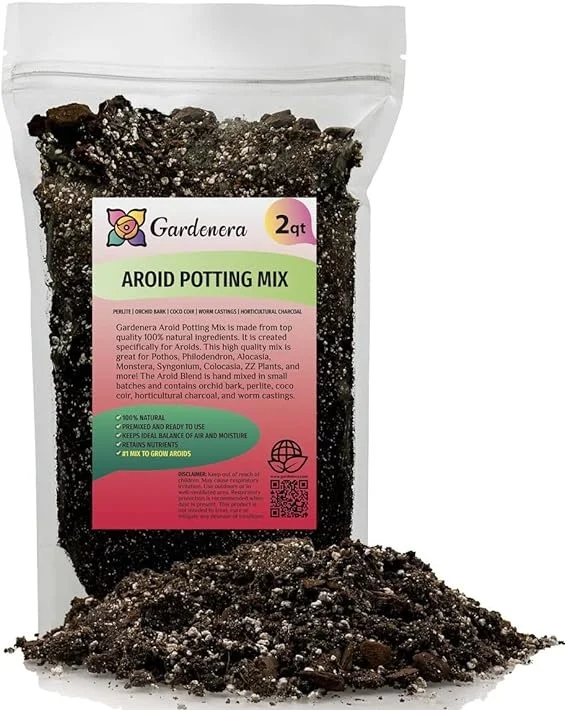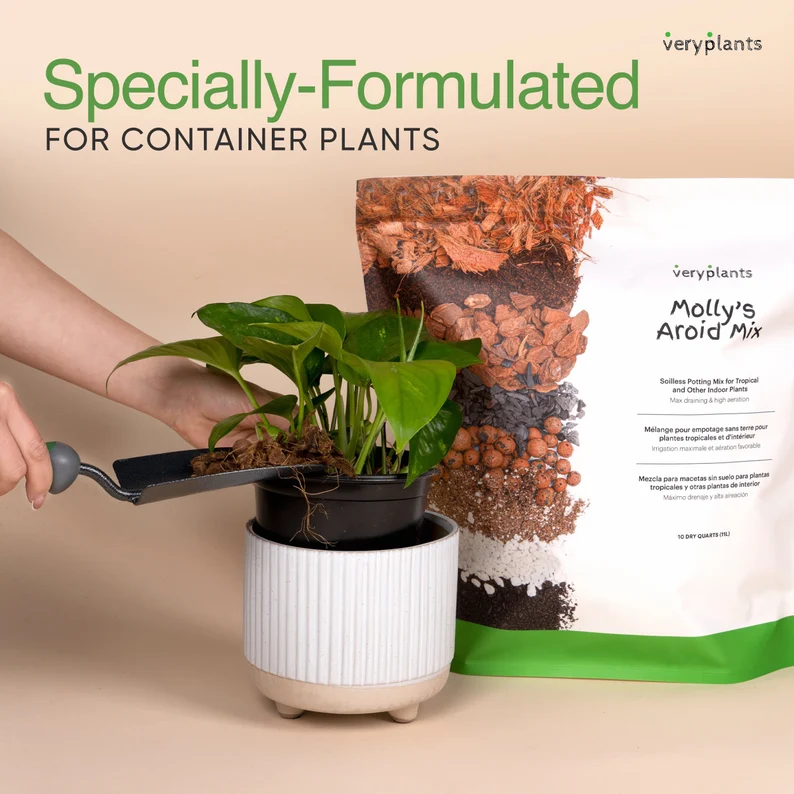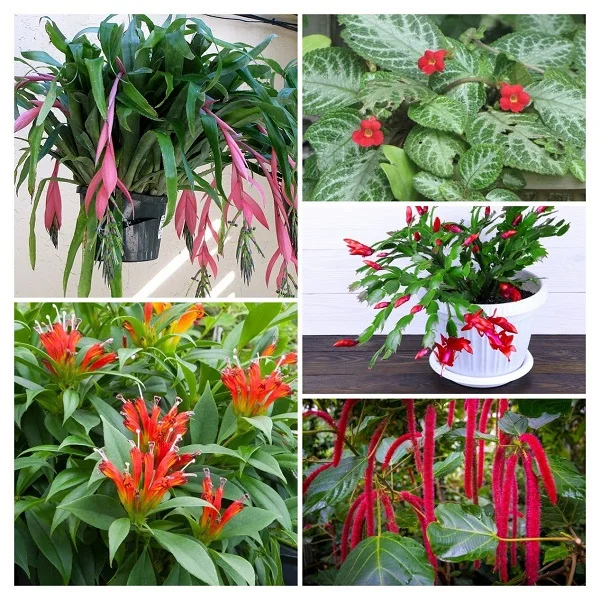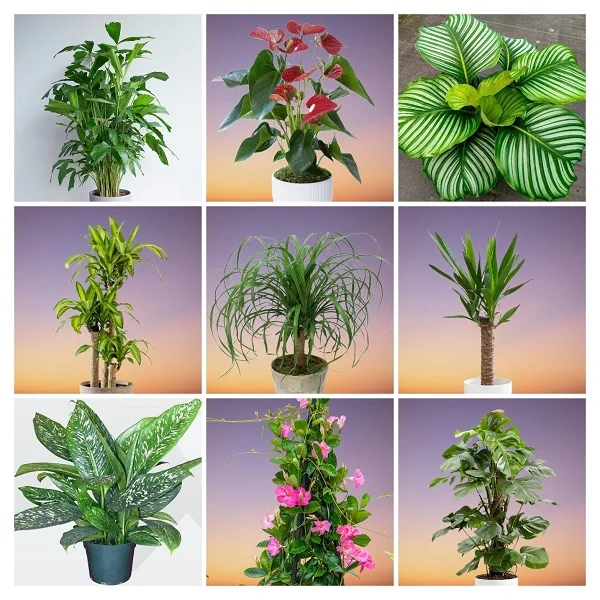Calathea crocata (Eternal Flame Plant) Indoor Care, Propagation, Problems and Solutions
Some links in this post may be affiliate links
Calathea crocata (Eternal Flame Plant) thrives in bright indirect light with some sunlight, warm and humid conditions and moderately moist, fertile, well-drained soil coupled with monthly feeding during the growing season.
Calathea crocata also called Saffron-coloured Calathea is one of the unique, popular Calathea varieties and has quite colorful foliage and a display of erect orange-red flowers.
The common name, 'Eternal Flame', is in reference to the spectacular, long-lasting blooms that it produces in summer. The blooms can last for 2 to 3 months and places it among the best flowering plants for the home or office space.
Saffron-coloured Calathea bears magnificent, slightly wrinkled, metallic, dark-green leaves with purple to brown tones on the undersides. It is among the popular purple-leafed plants for indoor growing.
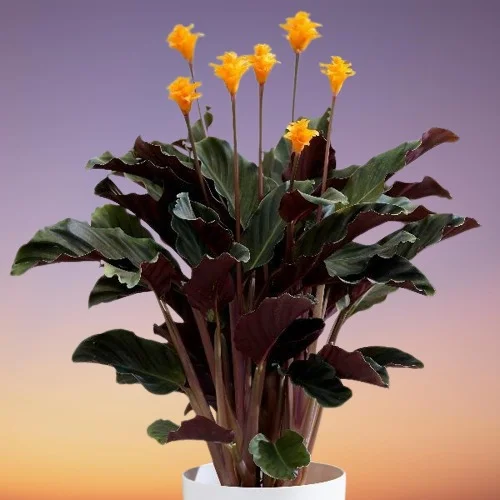
Botanical name: Calathea crocata
Synonym: Goeppertia crocata
Family: Marantaceae
Common name: Eternal Flame Plant, Saffron-coloured Calathea
Origin
Calathea crocata also called Goeppertia crocata is native to Bahia and Espírito Santo states of eastern Brazil where it grows as an understory plant.
Size
Eternal Flame Plant is a small-sized plant which grows to a height of about 1.5 feet and about 1 ft wide. It is perfect for small spaces like a narrow window sill, table-top, desktop or shelf. On account of its magnificent foliage and striking blooms, Calathea crocata is one of the best plants for office space where it will create a great first impression.
Is Calathea crocata toxic to pets?
No. Calathea crocata like other Calathea Plants is non-toxic to both humans and pets as indicated by ASPCA. The plant is safe for cats, dogs and other pets.
Related Plants
Calathea crocata is closely related to the Marantas, Ctenanthe and Stromanthe These groups of plants are collectively called Prayer Plants in reference to their curious characteristic of closing their leaves at night.
Where to buy
If you would like to add these gorgeous plants to your collection, they are available online on Etsy (Link to Etsy).
How do you care for Calathea crocata indoors?
To care for Calathea crocata indoors, provide bright indirect light with 4-6 hours of sunlight, average warmth of 18-260C, humidity of 70-80% and moderately moist, fertile, well-drained soil coupled with monthly feeding during the growing season.
Calathea Eternal Flame care requires pruning to keep it neat and also reduce pest and disease infestations. Repotting is needed when the plant becomes extremely pot-bound as it blooms best when slightly root-bound. Keep reading for more on the best growing conditions for this plant and how to achieve them.

Watering
How do you water Calathea crocata?
Water your Calathea crocata liberally in spring and summer and allow the top 2-3 inches of soil to dry out. Keep the soil moderately moist and avoid overwatering to prevent yellowing, rotting and drooping leaves.
Decrease watering in fall and winter as growth is minimal at this time. but do not allow the soil to dry out completely to avoid wilting, drooping and curling leaves.
Use room temperature water to prevent cold shock which can result in stunted growth and death of the plant. Ascertain that the water is free of chlorine, flourides and other chemicals to prevent brown leaf tips and edges.
Make sure that the pot has a drainage hole and the soil is well-draining to prevent waterlogging which can lead to root-rot.
To prevent fungal infestations like leaf spot disease, avoid wetting the foliage; water from the bottom instead.
Light Requirements
Eternal Flame Plant grows best in bright indirect light with 4-6 hours of morning or late evening sunlight to promote blooming (flowering). Keep it away from hot midday sunshine to prevent scorching and dullness of the leaf color.
Too little light may reduce growth and flowering. Therefore, if the lighting in your home is not adequate, use grow lights to supplement it.
For uniform growth of the plant, regularly turn the pot to ensure that the plant receives light on all sides.
Temperature and Humidity
Eternal Flame Plant prefers an average warmth of 18-260C; temperatures that are comfortable for you are perfect for this plant. Keep it away from drafts which lead to sudden changes in temperature as they can cause stunted growth and drooping leaves.
Calathea crocata requires humidity of 70-80% to thrive. Low humidity will result in brown leaf tips and edges. Therefore, to elevate humidity, set the pot on a wet pebble tray, use a humidifier or group the plants together. Maintain good air circulation to minimize fungal diseases.
You may also grow the plant in a well-lit bathroom or in a terrarium as a high humidity can be maintained inside a terrarium.
Potting Mix
The best potting soil for Eternal Flame Plant should be a rich, loose, free-draining soil to prevent it from getting soggy while providing the required nutrients. A mix of peat-based soil for moisture retention, perlite or sand for aeration, and coconut coir or compost for added nutrients is ideal for these plants.
Feeding
Feed your Calathea crocata with a balanced, liquid fertilizer once monthly through out the growing season (spring and summer). The plant is not a heavy feeder, therefore, feeding once monthly should be adequate.
Withhold feeding in the cold season (fall and winter) as growth is minimal and feeding at this time can lead to fertilizer burn and death of the plant.
To promote flowering (blooming), feed the plant with a phosphorous-rich fertilizer weekly in the bud formation stage.
Regularly, flush out accumulated salts from the soil by running a stream of water through the soil. Allow the stream of water to run for some time and repeat the process several times.
Repotting
Repot your Calathea Eternal Flame every 2 years at the beginning of the growing season (spring to early summer), when it becomes extremely pot-bound as it blooms best when slightly root-bound.
Use a pot one size larger than the current one. Ensure that the pot has a drainage hole to prevent the soil from getting soggy as it can lead to root-rot. Check out these pots with drainage holes on Amazon.
Before repotting, water the plant thoroughly at least one day before to hasten establishment; a well hydrated plant suffers less repotting shock and takes a shorter time to take root.
If the plant is large and has outgrown its current pot, divide it into several sections and use the splits to propagate new plants.
Note that repotting may cause the leaves to droop but the plant will eventually recover in about 3-4 weeks once it takes root.
Pruning & Grooming
Pruning Calathea crocata is easy as it involves:
- Regular removal of dead and yellow foliage to maintain the plant neat and also discourage pest and disease infestations. Cut the leaves with a clean, sharp knife or scissors at the base, where the leaf meets the stalk.
- Removal the spent blooms as soon as they die to keep the plant neat and tidy as well reduce breeding ground for pests and diseases.
Regularly, damp-wipe the leaves with a soft cloth to keep them clean and neat as well as reduce pest and disease infestations.
Calathea crocata Propagation
Calathea crocata (Eternal Flame Plant) is best propagated by plant division at the beginning of the growing season (in spring). Dividing the plant at this time hastens establishment as it is in the active growth phase.
Learn how to propagate Calathea Plants in 2 easy ways.
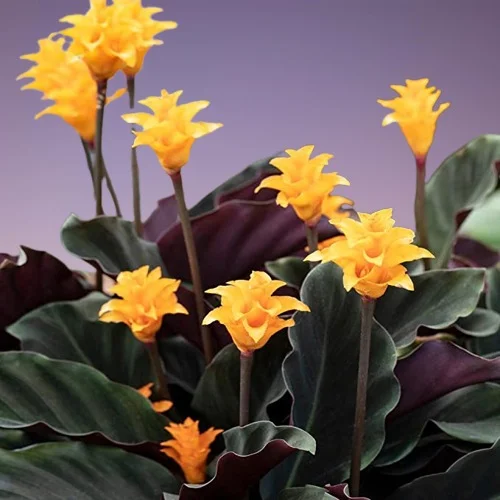
Calathea crocata Problems & Remedies
Calathea crocata (Eternal Flame Plant) problems are brown leaves, plant dying, leaf drop, yellow leaves, lack of blooms, brown leaf tips, curling leaves, washed out leaves, pests and diseases among others. Keep reading for more on these problems, their remedies and solutions.
Brown leaves
Why are the leaves on my Calathea crocata turning brown?
The main causes of brown leaves on your Calathea crocata are inconsistent watering, temperature stress, hot sunlight, and aging.
How to fix it
Inconsistent water: Water when the top 2-3 inches of soil dry. Never allow the soil to dry out completely.
Temperatute stress: Protect the plant from drafts emanating from AC units, heat sources, windy doors and others.
Hot sunlight: Keep the plant away from hot midday sunlight or use a light curtain to filter the sunshine.
Aging: This is a natural process; as the plant matures the lower leaves turn brown and begin to die.
Plant dying
Why is my Calathea crocata dying?
Your Calathea crocata is dying due to root-rot or spider mites infestation.
How to fix it
Root-rot: The diseases is prevalent in soggy soil. It is characterized by yellowing and wilting of the leaves which is rapidly followed by browning and plant collapse.
- Carefully remove the plant from its pot and inspect the roots.
- Trim the brown-black, mushy roots and treat the healthy roots with a copper-based fungicidal solution as indicated on the label.
- Disinfect the pot with the fungicidal solution or use a fresh pot to repot the plant in fresh, well-draining soil.
- Do not water the plant immediately and keep it dry for 5-7 days before you can resume watering.
- Use a pot with a drainage hole and well-draining soil to prevent the soil from getting soggy.
- Cut down on watering in fall and winter as growth is slowed at this time; keep the soil slightly moist.
Spider mites infestations: Regularly check underneath the leaves for these pests and carry out timely control measures. Raise humidity to discourage the pests.
Check out these 12 Reasons Why Calathea is Dying and How to Save It
Drooping leaves
Drooping leaves on Calathea crocata is caused by dry air, incorrect watering, soggy soil, and being pot-bound.
How to fix it
Dry air: To increase humidity, set the pot on a wet pebble tray, use a humidifier, group the plants together or grow the plant in a terrarium.
Incorrect watering: Water when the top 2-3 inches dry out but do not allow the soil to dry out completely.
Soggy soil: Ensure that the soil is free-draining and that the pot has a drainage hole.
Being pot-bound: Repot the plant into a pot one size larger than the current one or divide it into several sections to propagate new plants.
Check out these 10 Causes of Calathea Drooping Leaves and How to Revive It
Lack of blooms
Why is my Eternal Flame Plant not blooming?
Lack of blooms on your Eternal Flame Plant is caused by too little light, underfeeding, underwatering, and low humidity.
How to fix it
Too little light: Position the the plant in a brighter spot or instal a grow light if the natural lighting is not adequate.
Underfeeding: To promote flowering, feed with a phosphorous-rich fertilizer weekly during the bud formation stage.
Underwatering: Water when the top 2-3 inches of soil feel dry. Do not allow the soil to dry out excessively.
Low humidity: Use a wet pebble tray or a humidifier to increase humidity.
Yellow leaves
Some of the causes of yellow leaves on Eternal Flame Plant are overwatering, soggy soil, nutrient deficiency, and temperature stress.
How to fix it
Overwatering: Do not water on a schedule. Water only when the top 2-3 inches of soil dry.
Soggy soil: Use a well-draining potting soil and a pot that has a drainage hole.
Nutrient deficiency: Apply a balanced, water-soluble fertilizer every 4 weeks in spring and summer.
Temperature stress: Keep the plant away from drafts coming from hot surfaces, hot air vents, AC units, windy doors among others.
Brown leaf tips and edges
Brown leaf tips and edges on Eternal Flame Plant are caused by dry air, spider mites infestation, hard water, and salts buildup.
How to fix it
Dry air: To raise humidity, set the pot on a wet pebble tray or grow the plant in a well-lit bathroom and other moist areas in the home.
Spider mites infestation: Remove the dead growth and raise humidity to discourage the pests.
Hard water: Water the plant with chlorine-free water only like rain water or filtered water.
Salts buildup: Regularly, flush out accumulated salts from the soil by running a stream of water through the soil.
Curling leaves
Curling leaves on Calathea crocata are caused by underwatering, dry air, drafts, and being pot-bound.
How to fix it
Underwatering: Keep the soil consistently moist during the growing season and slightly moist in the cold season. Never allow the soil to dry out completely.
Dry air: To increase air moisture, set the pot on a wet pebble tray, use a humidifier or place the plant in a well-lit bathroom.
Drafts: Keep the plant away from drafts emanating from AC units, heat sources, windy doors, drafty windows among others.
Being pot-bound: Repot the plant in spring, into a pot 1 size larger, every 1-2 years or when it gets root-bound.
Washed out leaves
Washed out leaves on Eternal Flame Plant is caused by too much sunlight. Move the plant to a more shaded spot or instal a light curtain to filter the sunlight to prevent death of the plant.
Pests
Calathea crocata is prone to mealybugs, aphids, scale insects and spider mites which are prevalent in low humidity.
How to fix it
- Isolate the affected plant to prevent spread to the other plants.
- Treat the infested plant with neem oil or insecticidal soap as per the manufacturers instructions.
- Regularly check underneath the leaves for these pests and carry out timely control measures.
- Keep the plant properly pruned and elevate humidity to discourage pest infestation.
Diseases
Calathea crocata is prone to leaf spot disease which is enhanced by the humid conditions in which it grows. The disease is indicated by brown patches surrounded by a yellow halo (brown, soft leaf spots).
How to fix it
- Remove and burn the affected parts to reduce the risk of spread to the rest of the plants.
- Spray the affected plant with a systemic fungicide and ensure to cover all the parts with the fungicidal solution.
- Keep the plant on the dry side, do not mist it and ensure good air flow.
- Use a pot with a drainage hole and well-draining soil.
Conclusion
Calathea crocata (Eternal Flame Plant) is a stunning indoor plant that adds warmth and elegance to any home. With proper light, water, humidity, and care, it can thrive and bloom beautifully indoors. Regular pruning and repotting will keep your plant vibrant and healthy. If you encounter any issues, timely adjustments will ensure its longevity and growth.
You liked it? Share on social media.
Related Content
Amazon Associates Disclosure
Homeplantsguide.com is a participant in the Amazon Services LLC Associates Program, an affiliate advertising program designed to provide a means for sites to earn advertising fees by advertising and linking to amazon.com.
